As Russian Losses Hit Historic One Million Mark, Ukraine Strikes Electronics Plant Near Moscow While Republican Senators Warn Trump About KGB Tactics and Xi’s Chess Game
Summary of the Day – June 12, 2025
Russian losses hit one million killed and wounded as Ukraine struck Moscow’s Rezonit electronics plant and advanced into Dnipropetrovsk Oblast. Republican senators warned Trump that “weakness provokes a KGB man” while pushing bipartisan sanctions as Germany offered IRIS-T systems but refused Taurus missiles. Marco Rubio congratulated Russia on its National Day—first since invasion—drawing Ukrainian rebuke amid Israeli strikes on Iran. NATO’s gunpowder crisis exposed: Russia produces in three months what the alliance makes yearly. Ukraine-Russia prisoner exchanges continued under Istanbul accords while China replaced its Ukraine peace envoy and 100,000 Russian families sought missing soldiers.

Families of Ukrainian POW’s turn to those released during the 66th prisoner exchange, hoping to find out about their missed loved ones in an unspecified area of Ukraine. Ukraine returned the third group of military personnel, most held in Russian captivity since 2022, as part of a new prisoner exchange that was agreed upon by the Ukrainian and Russian delegations in Istanbul, Turkey. (Maksym Kishka/Suspilne Ukraine/JSC “UA:PBC”/Global Images Ukraine via Getty Images)
One Million Ghosts: Putin’s Pyrrhic Victory Reaches Historic Toll
The Ukrainian General Staff announced that Russian forces have sustained over one million casualties since launching their full-scale invasion, with more than half occurring since January 2024. The grim milestone represents an unprecedented hemorrhaging of human life as Russia burns through personnel at an average rate of 1,286 soldiers per day in 2025.
The casualty breakdown revealed the escalating cost of Putin’s territorial ambitions: 106,720 in 2022 averaging 340 per day, 253,290 in 2023 averaging 693 per day, and 430,790 in 2024 averaging 1,177 per day. By June 2025, Russian forces already exceeded 200,000 casualties for the year, demonstrating unsustainable attrition rates.
Ukrainian Presidential Deputy Head Pavlo Palisa calculated that Russia sustains roughly 167 casualties per square kilometer of advance. Despite these catastrophic losses, Russian forces seized more territory in May 2025 than any month since late 2022, highlighting the Kremlin’s willingness to accept disproportionate sacrifices for marginal gains.
The million-casualty figure represents more than just statistics—it signifies the collapse of Russia’s professional military and its transformation into a contract-based force dependent on massive financial incentives. Sign-up bonuses have ballooned to $40,000 in some regions, creating unsustainable economic pressure on Russia’s war-strained budget.
NATO officials noted that Russian forces lose and recruit 35,000 to 45,000 personnel monthly, with recruitment barely keeping pace with battlefield losses. The human cost extends beyond military casualties to include the systematic destruction of Russia’s demographic future and economic stability.
Moscow’s Electronics Hub Burns: Ukraine’s Deep Strike Campaign Intensifies
Ukrainian Unmanned Systems Forces struck the Rezonit electronics plant in Moscow Oblast’s Zubovo Technopark overnight, targeting critical components for Russia’s most advanced weapons systems. The facility produces circuit boards and navigation systems for Iskander ballistic missiles, Kalibr cruise missiles, and Lancet loitering munitions.
Explosions rocked the facility 40 kilometers from Moscow’s center as Ukrainian drones penetrated deep into Russian airspace. The strike tore holes in the plant’s roof while secondary fires erupted across the complex. Russian authorities claimed to have shot down 52 Ukrainian drones but could not prevent the successful targeting of this “juicy target.”
The Rezonit plant represents a critical node in Russia’s defense industrial base, manufacturing the sophisticated electronics that enable precision strikes against Ukrainian cities. The facility’s destruction threatens Russia’s ability to produce guided munitions at scale while demonstrating Ukraine’s expanding deep-strike capabilities.
Ukrainian officials emphasized that such attacks form part of a systematic campaign to degrade Russia’s military-industrial capacity. The strike followed previous successful operations against gunpowder plants and ammunition depots, creating cascading effects throughout Russia’s weapons production network.
The successful penetration of Moscow’s air defenses showcased evolving Ukrainian drone technology and intelligence networks operating hundreds of kilometers inside Russian territory. The attack confirmed Ukraine’s ability to threaten strategic targets previously considered beyond Ukrainian reach.
Blood Across the Border: Russian Breakthrough Into Dnipropetrovsk
Russian forces achieved their first confirmed breakthrough across the Donetsk-Dnipropetrovsk Oblast border as elements of the 114th Motorized Rifle Brigade advanced along the T-0428 highway near Novoukrainka. The multi-pronged offensive represents Russia’s attempt to establish buffer zones beyond its illegally annexed territories.
Geolocated footage confirmed Russian seizure of Novoukrainka, Zelenyi Kut, Oleksiivka, and Bahatyr along the strategic highway connecting Kurakhove to Novopavlivka. The advance demonstrates Russian success in coordinating attacks from multiple directions while Ukrainian defenders face increasing pressure across extended front lines.
The breakthrough followed Russian claims of reaching the oblast border from the Velyka Novosilka direction with Eastern Grouping forces. Ukrainian sources reported 46 Russian assaults in the Novopavlivka direction—the highest intensity since the full-scale invasion began.
Russian motorcycle tactics enabled rapid advances across open terrain despite heavy casualties. Ukrainian Southern Defense Forces described Russian willingness to accept battalion-level losses weekly to maintain offensive momentum toward symbolically important objectives.
The territorial gains carry strategic implications beyond military value, providing Russia with propaganda victories while threatening critical Ukrainian logistics routes. The advances toward Dnipropetrovsk represent the deepest Russian penetration into previously secure Ukrainian territory since 2022.
GOP’s Putin Warning: “Weakness Provokes a KGB Man”
Republican Senator Chuck Grassley delivered a forceful Senate floor speech warning President Trump against repeating Biden’s mistakes with Putin, declaring that “weakness is what provokes a KGB man like Putin.” The Iowa senator urged Trump to give Ukraine necessary weapons rather than managing escalation.
“Had the West instead given the Ukrainians what they needed earlier, they might have pushed Russia out of their country by now,” Grassley argued, drawing parallels to Reagan’s approach toward Soviet leadership. The speech reflected growing Republican frustration with Trump’s reluctance to confront Putin decisively.
Grassley emphasized that Putin “thinks he can play President Trump,” warning against diplomatic naivety when dealing with former KGB operatives. The senator invoked Reagan’s Brandenburg Gate speech demanding Gorbachev “tear down this wall” as an example of principled leadership against tyranny.
Senator Bill Cassidy separately advocated crushing Russia’s oil trade, noting that Europe paid 22 billion euros for Russian natural gas in 2024—funds directly financing Putin’s war machine. The Louisiana senator promoted American LNG exports as alternatives to Russian energy dependence.
The bipartisan Sanctioning Russia Act of 2025, supported by 84 senators, aims to impose “bone-crushing” sanctions on Russia’s economy. Senators Graham and Blumenthal argued that Putin lies to Trump to avoid new sanctions while continuing his brutal war.
German Shields, Missing Swords: Berlin’s Mixed Signals on Ukraine Aid
Germany pledged continued IRIS-T air defense system deliveries under a three-year supply agreement while definitively ruling out Taurus long-range missile transfers. Defense Minister Boris Pistorius confirmed additional 1.9 billion euros in military support, bringing total German aid to 9 billion euros annually.
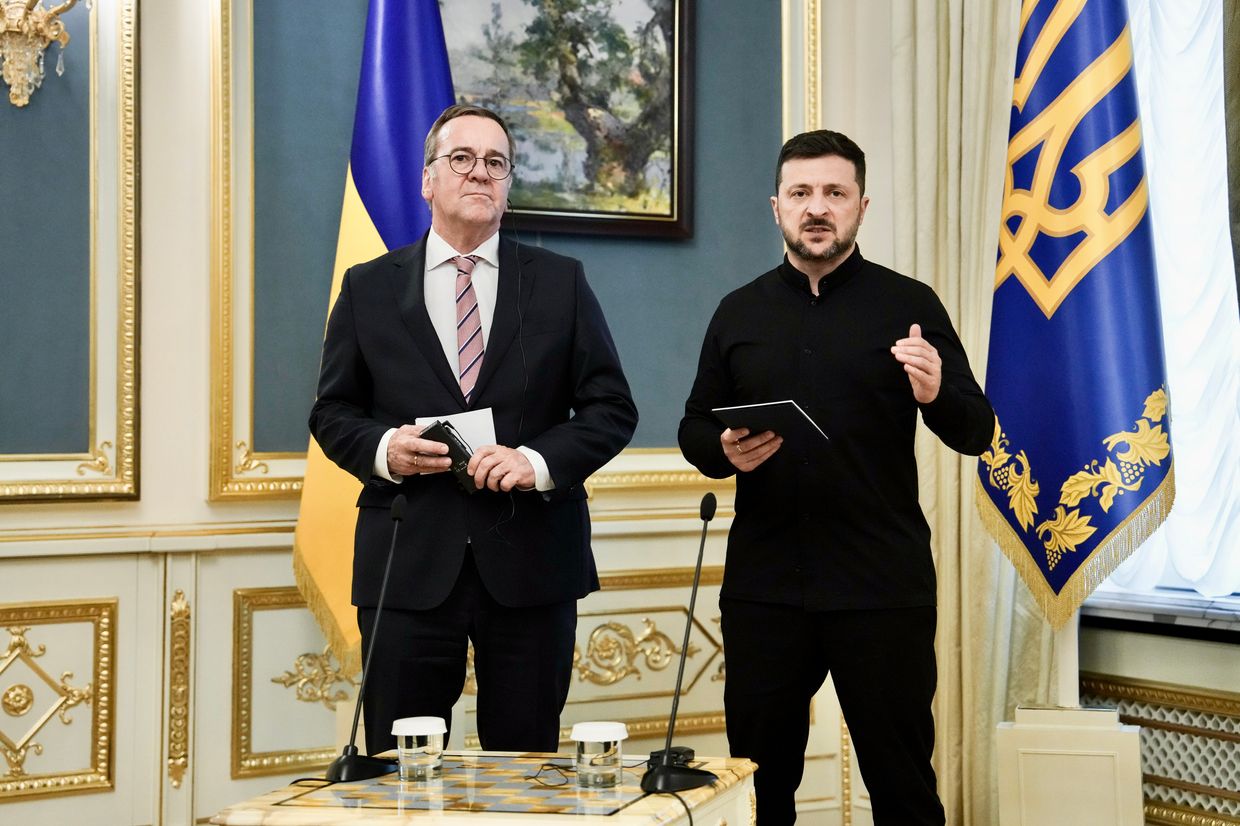
Boris Pistorius, Germany’s defense minister, and President Volodymyr Zelensky during a news conference in Kyiv, Ukraine. (Andrew Kravchenko / Bloomberg)
President Zelensky welcomed the air defense commitment amid escalating Russian aerial assaults, including the massive June 10 strike on Kyiv. The IRIS-T systems have proven crucial for intercepting Russian drones, aircraft, and cruise missiles targeting Ukrainian cities.
However, Pistorius firmly rejected Ukrainian requests for Taurus missiles capable of striking deep into Russian territory. “You asked me whether we are considering this, and my answer is no,” the defense minister stated, maintaining restrictions despite Ukrainian battlefield needs.
The decision disappointed Ukrainian officials who argue that long-range precision strikes against Russian military targets would significantly degrade Moscow’s offensive capabilities. Germany’s position contrasts with Britain and France, which provided Storm Shadow and SCALP missiles.
Chancellor Friedrich Merz had previously signaled openness to lifting the Taurus ban but has not implemented policy changes. The hesitation reflects German concerns about escalation despite Ukraine’s demonstrated restraint in targeting legitimate military objectives.
Homecoming Through Hell: Another POW Exchange Under Istanbul Accords
Ukraine brought home another group of severely wounded and chronically ill defenders in the third prisoner exchange since Istanbul agreements took effect. The humanitarian operation prioritized service members requiring urgent medical care after prolonged Russian captivity.
Among the returnees were defenders of Mariupol who spent over three years in Russian detention, many classified as missing in action. The exchanged prisoners included personnel from multiple military branches—Armed Forces, Navy, Air Force, National Guard, and specialized services.
Ukrainian officials emphasized that returned defenders suffered serious injuries including amputated limbs, vision problems, infections, and chronic diseases. Some prisoners showed signs of tuberculosis and hepatitis contracted during harsh detention conditions.
The phased exchange system agreed upon in Istanbul allows for systematic repatriation of the most vulnerable prisoners while Russia fulfills commitments to return up to 6,000 Ukrainian bodies. The agreements represent the only tangible progress from otherwise stalled peace negotiations.
Since Russia’s invasion began, over 5,000 Ukrainian POWs have returned home through various exchanges. However, thousands more remain in Russian captivity as Ukraine pushes for an “all-for-all” formula rejected by Moscow.
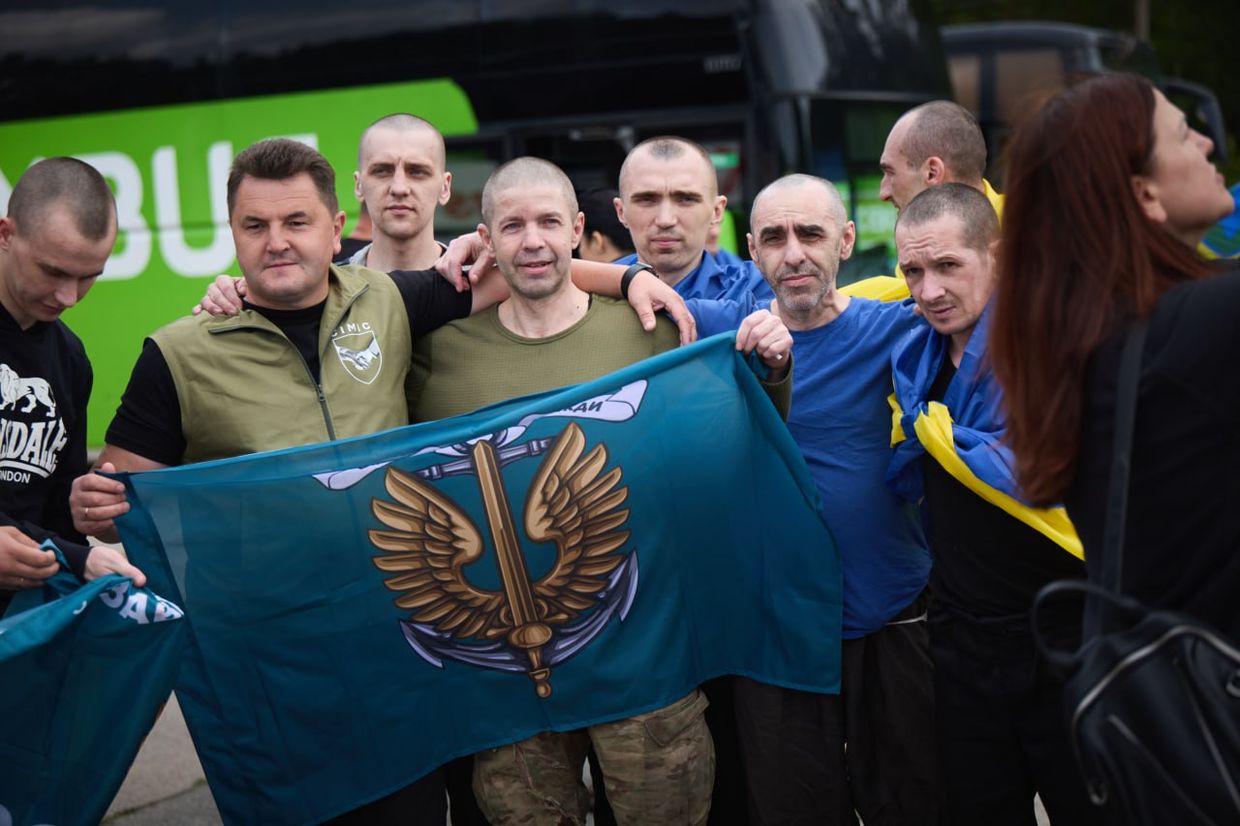
Ukrainian service members released from Russian captivity under a prisoner exchange. (President Volodymyr Zelensky/X)
KGB Officer’s Holiday: Rubio Congratulates Putin’s Russia Day
Secretary of State Marco Rubio congratulated the Russian people on Russia Day for the first time since the invasion, expressing hopes for “constructive engagement” and “mutually beneficial relations.” The statement marked a dramatic shift from Biden administration policies of isolation and pressure.
“The United States remains committed to supporting the Russian people as they continue to build on their aspirations for a brighter future,” Rubio declared in the State Department statement. The congratulations coincided with Russian forces sustaining record casualty rates in Ukraine.
Ukrainian Foreign Minister Andrii Sybiha condemned the congratulations as particularly “unpleasant” for a country under Russian aggression. “There can be no reward for the aggressor country,” Sybiha responded, exercising his “moral right” to criticize diplomatic normalization attempts.
The gesture reflects Trump administration efforts to restore U.S.-Russia relations despite ongoing warfare and war crimes. Washington has signaled readiness for economic cooperation while delaying implementation of bipartisan sanctions legislation.
Russia Day commemorates the 1991 declaration of sovereignty from the Soviet Union, ironically celebrating independence while Putin attempts to deny Ukrainian sovereignty. The holiday’s timing highlighted contradictions between Russian historical narratives and imperial ambitions.
Powder Keg Crisis: NATO’s Ammunition Shortage Exposed
NATO Secretary General Mark Rutte revealed that Russia produces in three months what the alliance manufactures in an entire year, exposing critical ammunition shortages that threaten Western security. The revelation highlighted NATO’s dangerous dependence on overseas suppliers for basic explosive materials.
The West’s ammunition crisis stems from decades of outsourcing gunpowder and explosives production to China and other countries with lax environmental controls. Modern weapons require nitrocellulose, TNT, and RDX—chemicals that leave massive environmental footprints during production.
European manufacturers like ChemRing Nobel and Rheinmetall announced massive capacity expansions but pointed to 2027 as the earliest date for meaningful production increases. The timeline leaves Ukraine desperately short of ammunition while NATO members face depleted stockpiles.
The shortage affects everything from 155mm artillery shells to precision-guided munitions, with production bottlenecks concentrated in chemical precursors rather than shell casings. China controls critical raw materials including cotton linters needed for nitrocellulose production.
American companies like BAE Systems explore revolutionary new processes to eliminate nitrocellulose dependence, but technological solutions remain years away. The crisis forced NATO to confront uncomfortable realities about defense industrial preparedness and supply chain vulnerabilities.
Sumy Counteroffensive: Ukrainian Forces Push Back Russian Advances
President Zelensky announced that Ukrainian forces are “gradually pushing back” Russian troops from Sumy Oblast after weeks of intensified cross-border assaults. The counteroffensive represents Ukraine’s first significant territorial recovery in the northeastern border region since March.
Russian forces had captured approximately 200 square kilometers in northern Sumy Oblast, including a dozen villages, while establishing a “security buffer zone” ordered by Putin. The advances triggered mandatory evacuations from 213 settlements as 50,000 Russian troops massed near the border.
Ukrainian resistance proved more effective than Russian commanders anticipated, with insider sources reporting catastrophic casualty rates during infantry-led assaults. Only eight of 100 Russian personnel reportedly survived recent attacks against Kindrativka before being immediately committed to follow-up operations.
The Sumy fighting demonstrated evolving Ukrainian defensive tactics adapted to Russian motorcycle and small-group assault methods. Ukrainian forces maintained defensive positions while inflicting disproportionate casualties on attacking formations.
Zelensky dismissed Russian claims of major territorial gains as propaganda designed to shape international perceptions. The president emphasized that Ukrainian forces successfully held off renewed offensives for nearly three weeks despite numerical disadvantages.
Middle East Earthquake: Israeli Strikes Shake Regional Balance
Israeli forces launched “Operation Rising Lion” against Iran’s nuclear program in a dramatic escalation that killed senior Iranian officials including IRGC Commander Hossein Salami. The strikes targeted uranium enrichment facilities and nuclear scientists in a multi-day operation threatening regional stability.
Prime Minister Netanyahu announced preemptive strikes against Iran’s main enrichment facility in Natanz while warning of expected retaliatory attacks against Israeli territory. Multiple explosions rocked Tehran as videos showed fires burning across the Iranian capital.

People look over damage to buildings following Israeli air strikes, in Tehran, Iran. (Photo by Majid Saeedi/Getty Images)
Iran’s Supreme Leader vowed “severe punishment” while accusing the United States of responsibility for the escalation. Secretary of State Rubio denied American involvement, emphasizing protection of U.S. forces in the region as the top priority.
The timing coincided with stalled U.S.-Iran nuclear negotiations and Trump’s preference for diplomatic solutions. However, Trump had warned that Israeli strikes “could happen” without progress on nuclear agreements.
The escalation carries implications for Ukraine as Iran supplies Russia with drones used against Ukrainian cities. Disruption of Iranian weapons production could affect Russian capabilities while potentially triggering broader Middle Eastern conflict.
Putin’s Drone Army: Russia Establishes Unmanned Systems Branch
Putin announced creation of a dedicated military branch for unmanned systems, formalizing Russia’s recognition of drone warfare as central to modern conflict. The decision follows Ukraine’s establishment of Unmanned Systems Forces in June 2024.
The new branch will encompass personnel training, manufacturing, and deployment of unmanned systems across air, land, and sea domains. Russia’s drone production has expanded dramatically with intentions to manufacture 500 drones daily while scaling tactical drone output to two million annually.
Russian drone capabilities rely heavily on Chinese components and foreign labor, including teenagers and African workers trafficked to production facilities. The workforce expansion enabled massive increases in Shahed-type suicide drone production.
The institutional changes reflect lessons learned from Ukraine’s innovative drone operations and the increasing importance of unmanned systems in reconnaissance, strike missions, and electronic warfare. Both sides now view drones as indispensable battlefield capabilities.
The militarization of drone technology promises to reshape future conflicts while raising concerns about proliferation to proxy forces and non-state actors worldwide.
Diplomatic Departures: American Envoys Exit Moscow and Kyiv
U.S. Ambassador to Moscow Lynne Tracy announced her departure after two years managing relations during the lowest point in U.S.-Russian ties since the Cold War. Her tenure involved negotiating prisoner releases including Wall Street Journal reporter Evan Gershkovich.
Tracy’s departure follows former Ambassador to Ukraine Bridget Brink’s resignation over opposition to Trump’s foreign policy approach. The simultaneous diplomatic transitions signal major shifts in American approaches toward both Ukraine and Russia.
The ambassador led U.S. efforts to maintain minimal diplomatic contact while implementing massive sanctions regimes against Russian officials and institutions. Her replacement will inherit Trump’s mandate to restore relations and pursue peace negotiations.
Russia appointed Alexander Darchiev as its new ambassador to Washington amid improving bilateral relations under the Trump administration. The mutual diplomatic reset reflects both sides’ interest in reducing tensions despite ongoing warfare.
Tracy’s farewell livestream marked the end of an era defined by confrontation, sanctions, and proxy warfare as both governments prepare for potential normalization efforts.
Economic Warfare: EU Targets Russian Fertilizers and Agricultural Exports
The European Union approved fresh tariffs on Russian and Belarusian fertilizers and remaining agricultural goods, gradually increasing over three years to reduce Moscow’s export revenues. The measures target products comprising 15% of Russian agricultural imports worth $1.5 billion annually.
Russian fertilizers accounted for over 25% of EU imports in 2023, creating dangerous dependencies that the new tariffs aim to eliminate. The graduated implementation allows European farmers time to find alternative suppliers while maintaining agricultural productivity.
Polish Trade Undersecretary Michal Baranowski emphasized that reduced Russian revenues directly impact Moscow’s ability to finance warfare. The tariffs complement existing restrictions on cereals, oilseeds, and other agricultural products.
The economic pressure comes as Russia’s budget faces increasing strain from military expenditures consuming 6.3% of GDP—the highest level since the Cold War. Energy revenues remain crucial for funding continued warfare.
Lithuania separately exposed Russian exploitation of medical exemptions to import dual-use goods with military applications. Customs authorities blocked nearly 29,000 shipments claiming medical purposes while containing vehicle parts and microelectronics.
NATO’s Watching Eyes: New Satellite System Monitors Eastern Borders
NATO unveiled the Smart Indication and Warning Broad Area Detection (SINBAD) satellite surveillance system designed to monitor military activity across Ukraine and alliance eastern borders. The AI-powered platform will provide unprecedented frequency scanning capabilities.
Admiral Pierre Vandier emphasized the system’s deterrent effect: “We’ll be able to tell them: we’re watching.” The capability addresses European concerns about monitoring potential ceasefire violations and troop movements.
The initiative partners with U.S. firm Planet Labs to reduce NATO’s dependence on American surveillance assets while maintaining alliance monitoring capabilities. European allies seek greater independence amid shifting U.S. foreign policy priorities.
SINBAD deployment coincides with preparations for a “coalition of the willing” supporting potential Ukraine peace agreements. At least 37 countries have joined discussions, with 15 ready to contribute troops for monitoring or enforcement roles.
The surveillance system represents NATO’s adaptation to hybrid warfare threats while preparing for potential peacekeeping missions in Ukraine.
Beijing’s Diplomatic Shuffle: China Replaces Ukraine Peace Envoy
China replaced its key Ukraine peace envoy Li Hui with Sun Linjiang, signaling potential shifts in Beijing’s mediation efforts after multiple failed diplomatic initiatives. The foreign ministry announced that Sun, formerly ambassador to Poland, would serve as special representative for Eurasian affairs.
Li Hui’s shuttle diplomacy across Europe failed to produce substantive outcomes despite multiple rounds of consultations with Ukrainian, Russian, and European officials. In 2024, Li admitted a “significant gap” existed between Kyiv and Moscow on peace prospects, highlighting the limitations of Chinese mediation efforts.
The replacement comes as China faces increasing Western criticism for its economic and diplomatic support of Russia while claiming neutrality. Beijing supplies crucial components for Russian weapons production while restricting Ukrainian access to similar technologies.
Sun brings experience from Poland, a key NATO ally supporting Ukraine, potentially offering different perspectives on European security dynamics. However, fundamental Chinese positions supporting Russian narratives remain unchanged despite personnel changes.
The diplomatic shuffle coincides with broader Chinese efforts to position itself as a global mediator while maintaining strategic partnerships with Moscow that undermine genuine neutrality claims.
Black Sea Triangle: Zelensky Hosts Historic Security Summit
President Zelensky convened a trilateral meeting with Moldovan President Maia Sandu and Romanian President Nicusor Dan, marking the first such gathering since Dan’s electoral victory over far-right, anti-Ukraine candidate George Simion. The talks focused on coordinating responses to Russian hybrid threats across the Black Sea region.
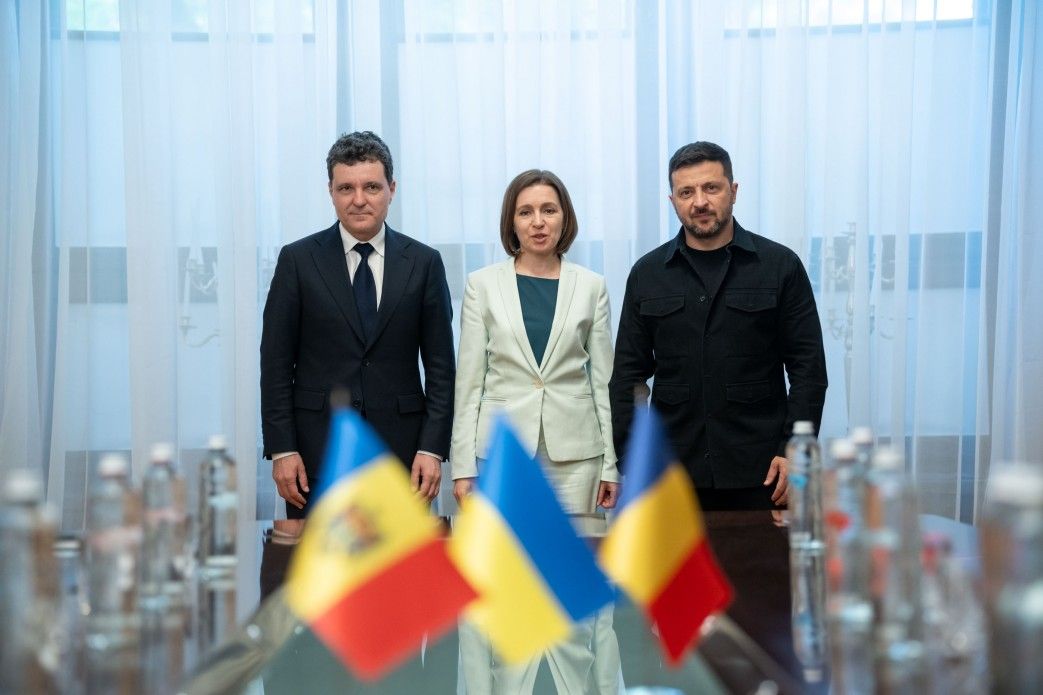
President Volodymyr Zelensky, Moldovan President Maia Sandu, and Romanian President Nicusor Dan pose for a photo during a trilateral meeting in Kyiv, Ukraine. (Presidential Office of Ukraine)
The leaders agreed to appoint foreign ministry-level coordinators for permanent contact among the three countries while addressing cybersecurity, defense cooperation, and EU integration challenges. Special attention focused on defending against Russian hybrid operations and cyberattacks intensifying across Black Sea states.
Infrastructure projects featured prominently, including cross-border highway construction and rail connection improvements linking Ukraine, Moldova, and Romania. The coordination aims to strengthen economic ties while reducing vulnerabilities to Russian pressure campaigns.
Zelensky emphasized unity between Ukraine and Moldova on their EU membership paths, warning against attempts to divide the countries during accession negotiations. Both received candidate status in 2022 and launched talks two years later.
Dan’s presidency represents a significant boost for Ukraine-Romania relations after defeating Eurosceptic opponents who opposed military aid for Kyiv. The trilateral format strengthens regional coordination against Russian destabilization efforts.
Tracking the Disappeared: US Program for Ukrainian Children Shuts Down
The leading U.S.-backed initiative documenting Russia’s abduction of Ukrainian children is preparing to close after Trump administration funding termination. Yale University’s Humanitarian Research Lab, spearheading the Ukraine Conflict Observatory, has transferred data to the State Department and Ukrainian government.
The observatory compiled evidence of Russian war crimes including deportation of Ukrainian children to reeducation camps or adoption by Russian families. The database contains records on over 30,000 allegedly abducted Ukrainian children from more than 100 locations.
“Right now, we are running on fumes,” Executive Director Nathaniel Raymond told CNN. “As of July 1, we lay off all staff across Ukraine and other teams, and our work tracking the kids officially ends.”
The program supported six International Criminal Court indictments, including two related to child abductions. Secretary of State Rubio temporarily restored funding to complete data transfers but confirmed ultimate defunding as part of efficiency cuts.
Bipartisan lawmakers urged Rubio to restore funding, warning that the program’s work “cannot be replaced by Europol or other organizations.” The closure leaves a major gap in accountability efforts as only 1,300 of the abducted children have been brought home.
Strategic Bombers Retreat: Russia Relocates Aircraft After Spiderweb Strikes
Russia redeployed dozens of long-range bombers to remote bases following Ukraine’s Operation Spiderweb that damaged 41 aircraft on June 1. All Tu-160 bombers evacuated from Belaya and Olenya airfields to distant locations in Chukotka, Kamchatka, and Tatarstan.
Tu-22M3 and Tu-95MS aircraft relocated to Ukrainka airfield in Amur Oblast, Engels-2 in Saratov Oblast, and other distant bases. The massive redeployment demonstrated the psychological impact of Ukraine’s unprecedented deep-strike operation against strategic aviation.
The relocations force Russian bombers to operate from bases thousands of kilometers from Ukraine, reducing sortie rates and increasing logistical complexity. The moves confirm Ukrainian success in threatening previously secure Russian strategic assets.
Western analysts praised Ukraine’s ingenuity in forcing Russia to rethink strategic posture across vast territories. NATO Admiral Pierre Vandier called the operation a modern “Trojan Horse” demonstrating Ukrainian technical sophistication.
The bomber dispersal represents Russia’s admission of vulnerability to Ukrainian drone warfare while complicating future strike operations against Ukrainian cities and infrastructure.
Crimean Drone Hub: Russia Converts Kerch Airport to Military Base
Russia officially transferred Kerch Airport in occupied Crimea to Defense Ministry control for indefinite military use, satellite imagery and registry data revealed. The former civilian facility is being converted into a drone warfare base with protective structures and camouflage installations.
Construction activity includes runway modifications suitable for drone launches and defensive positions for short-range air defense systems like Pantsir-S1 or Tor-M2. The airport ceased commercial operations in 2007 and previously served as a truck holding area.
The conversion demonstrates Russia’s militarization of occupied Crimea while adapting infrastructure for drone warfare requirements. Kerch’s strategic location near the Crimean Bridge provides operational advantages for attacks against Ukrainian targets.
Aviation experts noted that the new facilities could support various unmanned systems from reconnaissance drones to strike platforms. The modifications reflect Russia’s recognition of unmanned warfare as central to future military operations.
The militarization violates international law governing occupation while threatening increased drone attacks against Ukrainian territory from Crimean bases.
Voices from the Void: 100,000 Russian Families Seek Missing Soldiers
Over 100,000 Russian families contacted a Ukrainian-run initiative seeking information about missing soldiers, revealing the massive scale of Russian casualties hidden by Kremlin censorship. The “I Want to Find” project received a record 12,320 inquiries in May 2025 alone.
Ukrainian officials confirmed 2,415 Russian soldiers in captivity with 1,126 already exchanged for Ukrainian defenders. However, the true number of missing Russian troops significantly exceeds official acknowledgments as families search independently.
Analysis revealed that Russia’s 15th Separate Motorized Rifle Brigade accounts for 2,277 missing personnel—the highest of any single unit. Of the 20 most-affected units, 17 are motorized rifle brigades deployed in brutal “meat grinder” tactics.
The data showed 26% of missing soldiers were under 30, with the youngest reported missing at 18 and oldest at 67. Significantly, 75% of families submitting requests said they oppose Russia’s war in Ukraine.
The massive inquiry volume exposes the human cost of Putin’s war while revealing growing domestic opposition among families directly affected by military casualties.
Mali’s Torture Chambers: Wagner’s Systematic Brutality Exposed
A joint international investigation revealed that Russian Wagner mercenaries systematically detained, tortured, and forcibly disappeared hundreds of civilians in secret prisons across Mali since 2021. Six detention centers were identified where Wagner held civilians between 2022 and 2024.
Prisoners endured beatings, waterboarding, electric shocks, starvation, and confinement in sweltering metal containers. The systematic torture occurred at former UN bases and military installations across Mali with Malian government complicity.
The investigation was conducted as part of the Viktoriia project commemorating Ukrainian journalist Viktoriia Roshchyna, killed in Russian captivity in 2024. The parallel highlighted Russian brutality extending from Ukraine to Africa.
Wagner announced withdrawal from Mali as Russia transitions to state-controlled Africa Corps, but the documented abuses demonstrate the mercenary group’s criminal behavior across multiple continents. Human Rights Watch previously accused Wagner of deliberately killing 32 civilians in December 2024.
The torture revelations provide further evidence for international war crimes prosecutions while exposing Russian methods of control in client states.
Refugee Coordinator: EU Names Special Envoy for Ukrainian Displaced Persons
The European Union appointed former Commissioner Ylva Johansson as special envoy for Ukrainians in the bloc, overseeing long-term strategy for 4.26 million refugees currently holding temporary protection status. The newly created position coordinates EU initiatives for integration or repatriation.
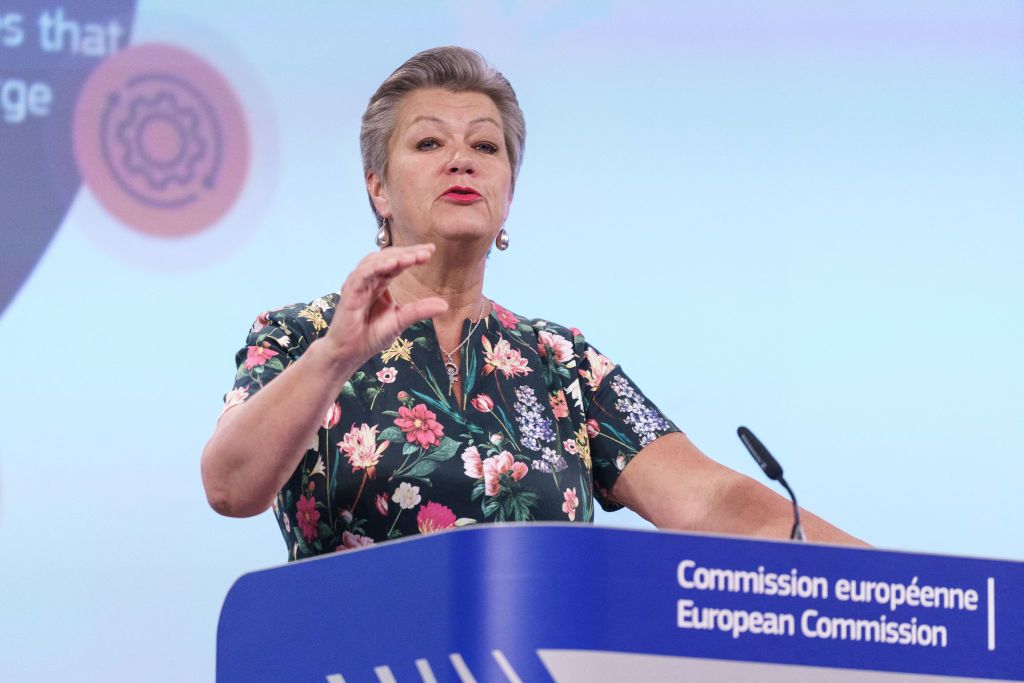
Ylva Johansson speaks during a press conference in Brussels. (Photo by SIMON WOHLFAHRT/AFP via Getty Images)
Johansson previously visited Ukrainian refugee camps and received Ukraine’s order of merit in September 2024. As special envoy, she will manage “unity hubs”—information centers jointly operated with Ukrainian government to support refugees.
The hubs will provide educational and career opportunities both in EU host countries and Ukraine while facilitating informed decisions about permanent settlement or return. Germany committed to establishing unity hubs in Berlin as part of broader refugee integration efforts.
The appointment reflects EU recognition that Ukrainian displacement will require sustained coordination beyond immediate humanitarian response. The bloc extended temporary protection status while preparing long-term integration mechanisms.
Johansson’s role addresses growing need for systematic approach to Ukrainian refugee management as the war continues with uncertain duration and outcome.
Oil Price Squeeze: G7 Prepares to Lower Russian Cap Without America
Most G7 nations are prepared to reduce the Russian oil price cap from $60 to $45 per barrel even without U.S. support, sources revealed. The EU and UK, backed by European G7 countries and Canada, are ready to lead the initiative despite American hesitation.
The price cap bans Western companies from shipping, insuring, or servicing Russian oil sold above designated prices to limit Kremlin war financing. Previous attempts to lower the cap failed after Treasury Secretary Scott Bessent declined support.
European allies view tighter restrictions as crucial for reducing Russian revenues while increasing economic pressure on Putin’s war machine. The $15 reduction could significantly impact Russian budget calculations dependent on energy exports.
The upcoming G7 summit in Canada on June 15-17 will revisit the price cap discussion with uncertain Japanese and American positions. President Zelensky expects to attend the summit seeking meetings with world leaders.
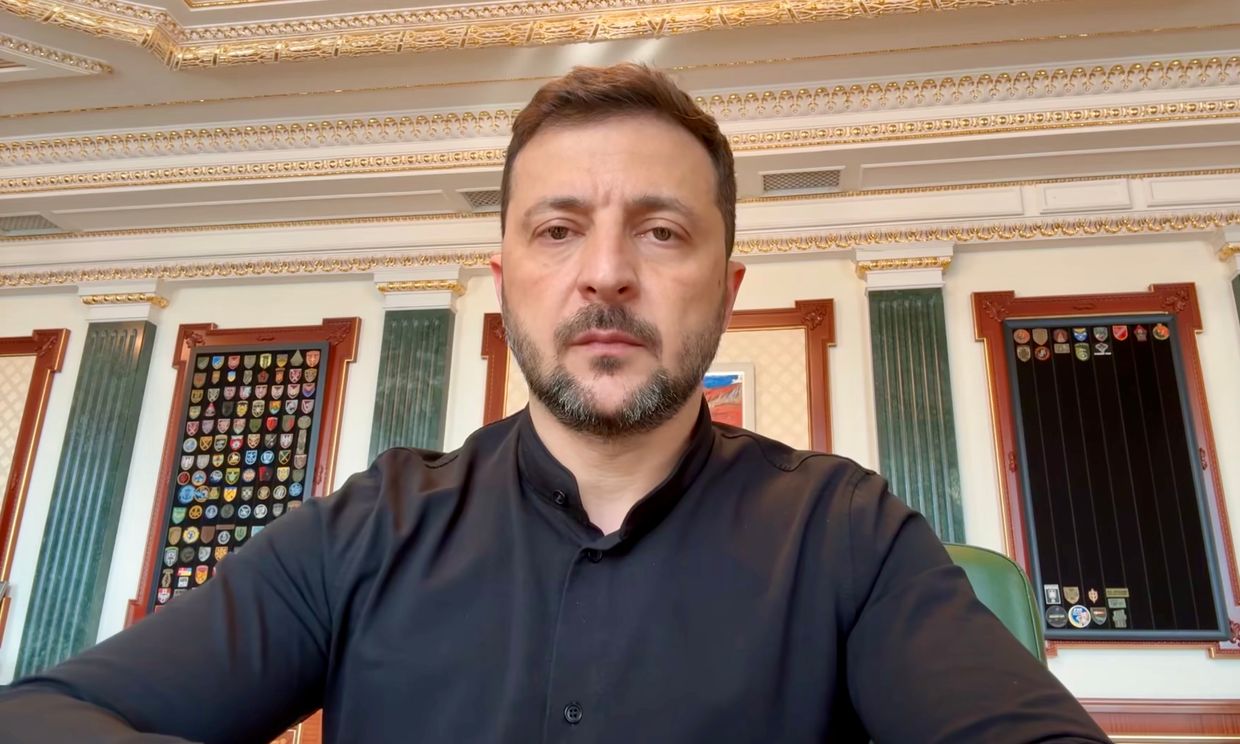
President Volodymyr Zelensky delivers his evening address, in Kyiv, Ukraine. (Zelensky / Telegram)
The potential split within G7 reflects broader tensions over sanctions policy as Trump administration prioritizes diplomatic engagement over economic pressure.
African Influence Campaign: Russia Targets Continental Youth Through Education
Russia is building pro-Kremlin influence networks across Africa by targeting youth and academic institutions with state-funded educational programs and cultural campaigns. Ukrainian military intelligence revealed systematic efforts to shape future African elites aligned with Moscow’s interests.
The Kremlin preserves and expands government-funded university quotas for African students in agriculture, engineering, pedagogy, and medicine. These programs build influence networks while providing technical skills under Russian ideological frameworks.
Moscow simultaneously introduces Russian language courses and teacher training initiatives in prominent African universities, aiming to synchronize educational systems with Russian standards. Sports programs complement academic initiatives as hybrid warfare tools.
“African education and sports are increasingly being used by Russia as tools of hybrid influence with a view to forming a new generation of political and administrative elites loyal to the Kremlin,” Ukrainian intelligence stated.
The influence operations exploit historical Soviet ties while offering academic and economic incentives to tilt African neutrality toward Russian positions on Ukraine and global issues.
Silencing Opposition: Russian Politician Faces House Arrest for “Bloody Chess” Comment
A Russian court placed opposition politician Lev Shlosberg under house arrest for two months after charging him with discrediting the army for describing Ukraine war as “bloody chess.” The Yabloko party senior member made the comment urging war’s end during January video debate.
The 61-year-old politician already designated a “foreign agent” faces up to five years in prison if convicted under legislation criminalizing criticism of Russian military operations. The case demonstrates intensifying repression against remaining opposition voices.
Yabloko leader Nikolai Rybakov defended Shlosberg as innocent, emphasizing that “he speaks of peace because he is convinced that the life of every human being has the highest value.” The arrest reflects Putin’s intolerance for any dissent regarding Ukraine war.
Shlosberg represents one of the few opposition politicians still remaining in Russia as most fled abroad or face imprisonment. The crackdown on domestic opposition accompanies broader efforts to eliminate independent civil society.
The “bloody chess” metaphor accurately captured the cynical calculation behind Putin’s territorial ambitions at enormous human cost, triggering harsh retaliation from authorities.
Kharkiv Under Fire Again: Children Among Latest Casualties
Russian forces launched another drone attack against Kharkiv overnight on June 12, injuring 15 people including four children in the second major assault within 24 hours. The attack struck residential areas, educational institutions, and civilian infrastructure with 11 confirmed drone impacts.
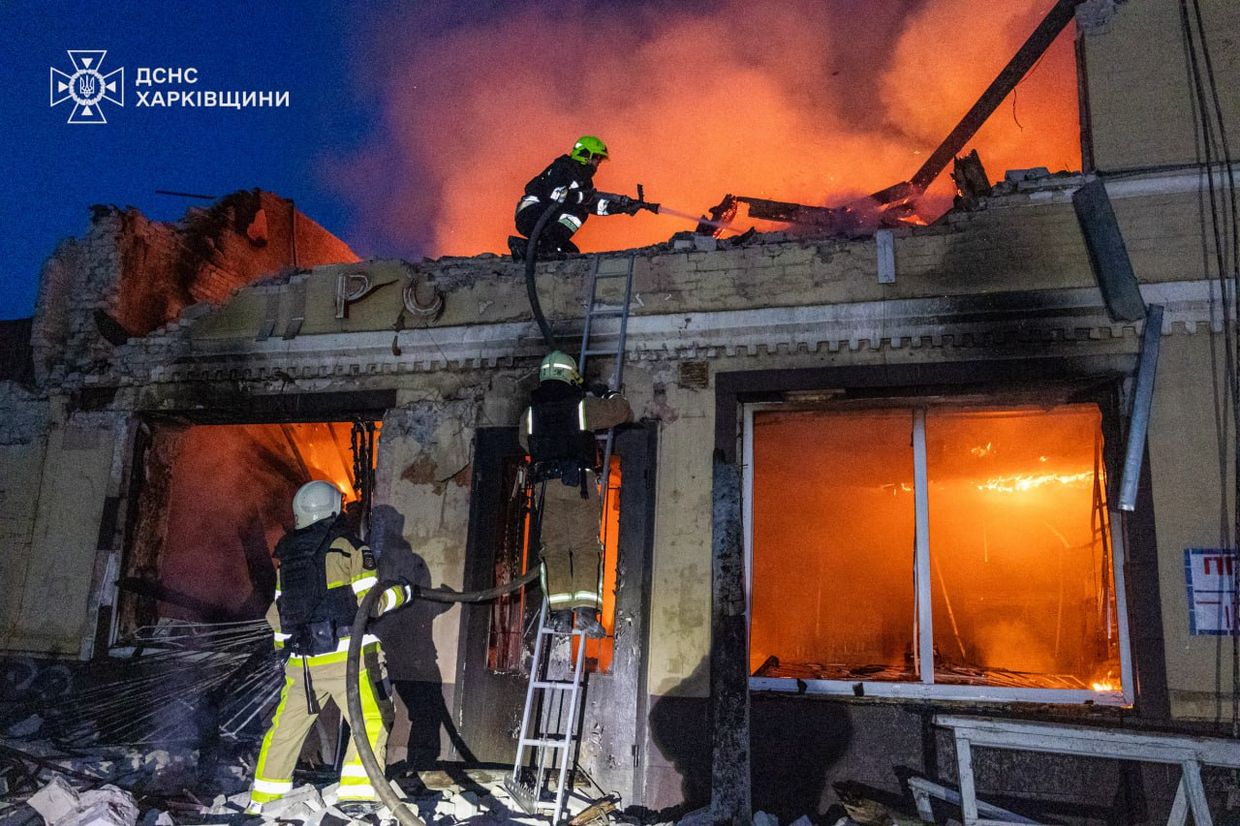
Firefighters extinguish a fire following a Russian drone attack on Kharkiv overnight. (State Emergency Service / Telegram)
The assault followed June 11’s massive attack that killed three civilians and wounded 64 others, including nine children. Russian forces have intensified targeting of Ukraine’s second-largest city with systematic attacks on civilian areas.
An unexploded drone was discovered on a warehouse roof while fires erupted throughout the city from direct hits and debris impacts. Educational facilities suffered damage in the Shevchenkivskyi district, endangering children’s access to schooling.
The escalating attacks coincide with Russian ground assaults along northeastern borders and demonstrate Moscow’s strategy of terrorizing civilian populations while pursuing territorial gains. Kharkiv’s proximity to Russian borders makes it particularly vulnerable to sustained bombardment.
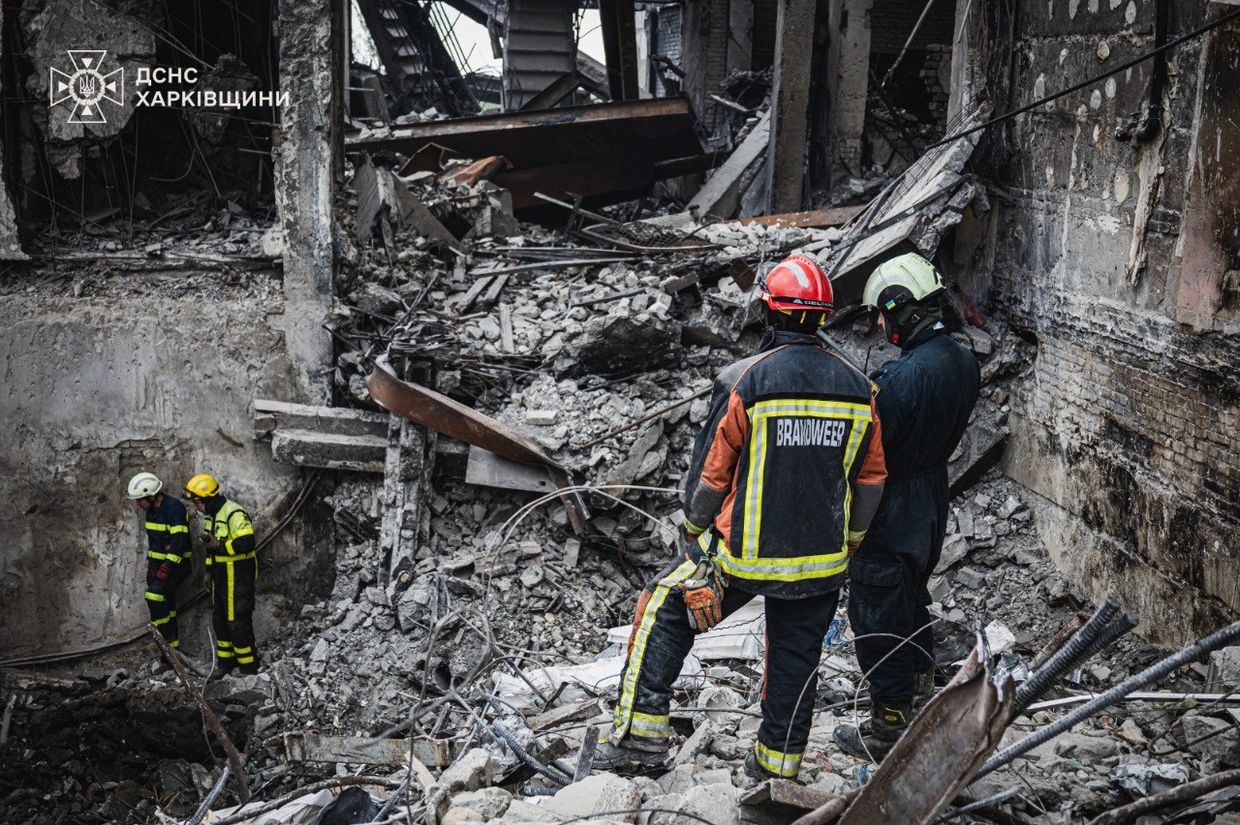
State Emergency Service workers are clearing out rubble on in Kharkiv, Ukraine, on June 12, 2025, following a Russian strike. (State Emergency Service/Telegram)
The targeting of children and educational infrastructure constitutes deliberate war crimes designed to break Ukrainian resistance through terror campaigns against the most vulnerable populations.
Putin’s Negotiation Deception: Zelensky Exposes Russian Stalling Tactics
President Zelensky accused Russia of deliberately delaying peace negotiations to avoid tougher U.S. sanctions while maintaining the illusion of diplomatic progress. Speaking to German media, Zelensky warned that Putin’s strategy involves showing Trump there’s a “diplomatic bridge” to prevent sanctions implementation.
“It’s important for them to show Trump that there is a diplomatic bridge between Ukraine and Russia, so that sanctions aren’t imposed against Russia,” Zelensky explained. The Ukrainian leader emphasized that Russia’s goal is buying time rather than achieving genuine peace.
Zelensky argued that Putin recognizes economic pressure mounting on Russia’s war-strained budget but wants to delay “strong sanctions” until his economy can no longer withstand additional pressure. The timing allows Russia to adapt defensive measures against financial restrictions.
“I think Russia is simply lying to Trump,” Zelensky stated, emphasizing Putin’s manipulation of diplomatic channels to avoid economic consequences. The strategy exploits Trump’s preference for negotiation over confrontation.
The revelation highlights fundamental disagreements over sanctions timing as Trump administration prioritizes diplomatic engagement while Ukraine advocates immediate economic pressure to force Russian concessions.
The events of June 12 crystallized the war’s brutal arithmetic as Russia’s million casualties exposed the unsustainable human cost of Putin’s imperial ambitions. Behind the grim milestone lay economic realities that threaten the Kremlin’s ability to maintain current casualty rates without fundamental changes to Russian society.
Ukrainian deep strikes against electronics plants near Moscow demonstrated expanding capabilities to threaten Russia’s military-industrial base while highlighting the Kremlin’s vulnerability despite territorial gains. The successful targeting of critical components for precision weapons promised cascading effects throughout Russia’s weapons production.
Republican senators’ warnings about Putin’s manipulation tactics reflected growing concerns that Trump’s diplomatic approach might repeat historical mistakes of appeasing authoritarian aggression. The KGB officer’s holiday congratulations symbolized broader questions about American commitment to defending democratic allies.
NATO’s ammunition shortage emerged as the alliance’s most critical vulnerability, with Russia’s three-month production exceeding Western annual output. The gunpowder crisis threatened not only Ukrainian resistance but the broader balance of power between democratic and authoritarian systems.
The simultaneous diplomatic transitions in Moscow and Kyiv signaled major shifts in American foreign policy as Trump’s administration pursued normalization with Russia despite ongoing atrocities. The contrast between humanitarian prisoner exchanges and celebratory diplomatic gestures highlighted moral contradictions in Western responses.
Middle Eastern escalation between Israel and Iran threatened to reshape regional dynamics while potentially disrupting Iranian drone supplies to Russia. The ripple effects of nuclear facility strikes could affect both Ukrainian battlefield capabilities and broader geopolitical alignments.
As Russian forces advanced into Dnipropetrovsk Oblast at catastrophic human cost, the mathematical reality of million-man losses suggested approaching inflection points in Putin’s war calculations. Whether economic pressure, military attrition, or diplomatic isolation would ultimately force strategic recalculation remained uncertain.
The West’s gunpowder shortage and NATO’s surveillance responses reflected deeper questions about democratic industrial capacity and strategic preparedness. Ukraine’s counteroffensive in Sumy Oblast demonstrated resilient defensive capabilities while Russian drone army expansion promised continued escalation.
The million ghosts of Putin’s war would forever haunt Russian society as the true cost of imperial delusion became impossible to hide from families across the federation. Whether this unprecedented toll would finally force recognition of warfare’s futility remained the defining question of the conflict’s next phase.
